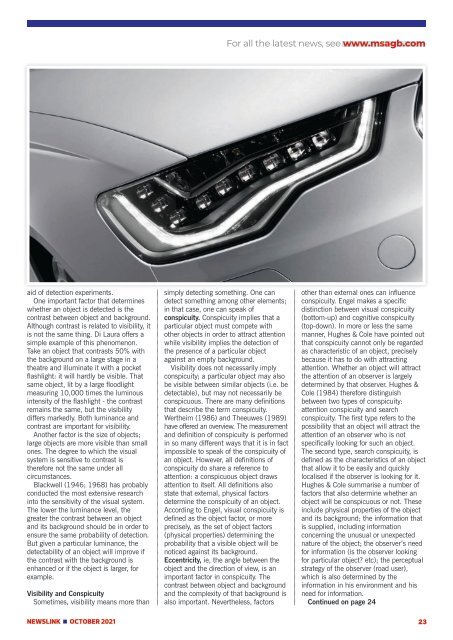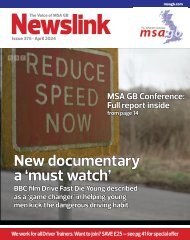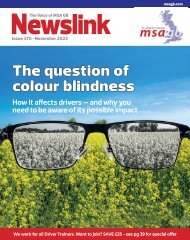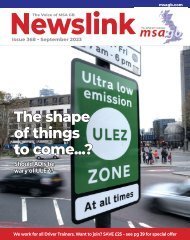Newslink October 2021
Membership magazine of the Motor Schools Association; road safety, driver training and testing news.
Membership magazine of the Motor Schools Association; road safety, driver training and testing news.
You also want an ePaper? Increase the reach of your titles
YUMPU automatically turns print PDFs into web optimized ePapers that Google loves.
For all the latest news, see www.msagb.com<br />
aid of detection experiments.<br />
One important factor that determines<br />
whether an object is detected is the<br />
contrast between object and background.<br />
Although contrast is related to visibility, it<br />
is not the same thing. Di Laura offers a<br />
simple example of this phenomenon.<br />
Take an object that contrasts 50% with<br />
the background on a large stage in a<br />
theatre and illuminate it with a pocket<br />
flashlight: it will hardly be visible. That<br />
same object, lit by a large floodlight<br />
measuring 10,000 times the luminous<br />
intensity of the flashlight - the contrast<br />
remains the same, but the visibility<br />
differs markedly. Both luminance and<br />
contrast are important for visibility.<br />
Another factor is the size of objects;<br />
large objects are more visible than small<br />
ones. The degree to which the visual<br />
system is sensitive to contrast is<br />
therefore not the same under all<br />
circumstances.<br />
Blackwell (1946; 1968) has probably<br />
conducted the most extensive research<br />
into the sensitivity of the visual system.<br />
The lower the luminance level, the<br />
greater the contrast between an object<br />
and its background should be in order to<br />
ensure the same probability of detection.<br />
But given a particular luminance, the<br />
detectability of an object will improve if<br />
the contrast with the background is<br />
enhanced or if the object is larger, for<br />
example.<br />
Visibility and Conspicuity<br />
Sometimes, visibility means more than<br />
simply detecting something. One can<br />
detect something among other elements;<br />
in that case, one can speak of<br />
conspicuity. Conspicuity implies that a<br />
particular object must compete with<br />
other objects in order to attract attention<br />
while visibility implies the detection of<br />
the presence of a particular object<br />
against an empty background.<br />
Visibility does not necessarily imply<br />
conspicuity; a particular object may also<br />
be visible between similar objects (i.e. be<br />
detectable), but may not necessarily be<br />
conspicuous. There are many definitions<br />
that describe the term conspicuity.<br />
Wertheim (1986) and Theeuwes (1989)<br />
have offered an overview. The measurement<br />
and definition of conspicuity is performed<br />
in so many different ways that it is in fact<br />
impossible to speak of the conspicuity of<br />
an object. However, all definitions of<br />
conspicuity do share a reference to<br />
attention: a conspicuous object draws<br />
attention to itself. All definitions also<br />
state that external, physical factors<br />
determine the conspicuity of an object.<br />
According to Engel, visual conspicuity is<br />
defined as the object factor, or more<br />
precisely, as the set of object factors<br />
(physical properties) determining the<br />
probability that a visible object will be<br />
noticed against its background.<br />
Eccentricity, ie, the angle between the<br />
object and the direction of view, is an<br />
important factor in conspicuity. The<br />
contrast between object and background<br />
and the complexity of that background is<br />
also important. Nevertheless, factors<br />
other than external ones can influence<br />
conspicuity. Engel makes a specific<br />
distinction between visual conspicuity<br />
(bottom-up) and cognitive conspicuity<br />
(top-down). In more or less the same<br />
manner, Hughes & Cole have pointed out<br />
that conspicuity cannot only be regarded<br />
as characteristic of an object, precisely<br />
because it has to do with attracting<br />
attention. Whether an object will attract<br />
the attention of an observer is largely<br />
determined by that observer. Hughes &<br />
Cole (1984) therefore distinguish<br />
between two types of conspicuity:<br />
attention conspicuity and search<br />
conspicuity. The first type refers to the<br />
possibility that an object will attract the<br />
attention of an observer who is not<br />
specifically looking for such an object.<br />
The second type, search conspicuity, is<br />
defined as the characteristics of an object<br />
that allow it to be easily and quickly<br />
localised if the observer is looking for it.<br />
Hughes & Cole summarise a number of<br />
factors that also determine whether an<br />
object will be conspicuous or not. These<br />
include physical properties of the object<br />
and its background; the information that<br />
is supplied, including information<br />
concerning the unusual or unexpected<br />
nature of the object; the observer’s need<br />
for information (is the observer looking<br />
for particular object? etc); the perceptual<br />
strategy of the observer (road user),<br />
which is also determined by the<br />
information in his environment and his<br />
need for information.<br />
Continued on page 24<br />
NEWSLINK n OCTOBER <strong>2021</strong><br />
23

















